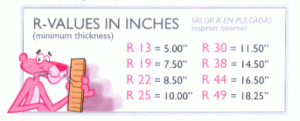FAQs
Be Comfortable this Summer and Save Energy and Money!
Insulation is just as important in the summer as it is in the winter. A well-insulated house will be cool in summer and warm in winter. Attics are the most important place to insulate for keeping cool in warm weather. Most homes absorb heat through the roof, so insulating the attic floor stops heat from reaching the rest of the house.
Click for more information
Affordability
If your attic floor is uninsulated or poorly insulated, you will quickly recoup the costs of insulating, with lower energy bills year-round. For both heating and cooling, the attic is generally the most cost-effective place to add insulation. If you are building a house, good insulation installed properly will reduce your heating and cooling needs and save you money.
Cost Savings
A well-insulated attic can save you money year-round, reducing energy use related to heating and cooling by 20% or more.
Insulation Tax Credit
Claim a 10% Tax Credit up to $500 on your 2013 Federal Tax Return. Insulating your attic with Owens Corning insulation qualifies you for a tax credit for 10% of the cost of materials for qualifying insulation projects throughout 2011, up to a maximum of $500.
Health & Comfort
A well-insulated house is a more comfortable one. Insulation holds in heat in cold weather and keeps your home cool in hot weather.
Environmental Considerations
The energy savings from insulating benefit the environment, but not all insulations have equal environmental impacts. Some involve toxic manufacturing processes and are hazardous to install. There are insulations available made from recycled waste materials. Research the options for the type of insulation you require.
What you Need to Know
The insulating properties of any material are referred to by their RSI or R-value. RSI or R-value is an indication of how well something resists the transfer of heat. The higher the RSI or R-value of a material, the more it will resist heat transfer.
Insulation will rest heat flow in either direction, keeping the house warm in winter and cool in summer.
An attic with too little insulation will waste energy and money in both winter and summer.
An R-value of 40 to 50 (RSI seven to 8.8) is recommended for attic insulation in most parts of U.S. .Find the recommended R-value for attic insulation in your area. It is generally better to insulate to a higher R-value than the minimum recommended level.
Before you add more insulation to your attic, you need to know the R-value of what currently exists. Measure the thickness of your attic’s insulation. To achieve R-40, you will need approximately 34 cm (13.5 inches) of fibreglass blanket insulation. For R-50, you would need about 43 cm (16.75 inches).
Insulation materials have what is called a “settled density,” which is the thickness they will retain over time. The settled density equates to the R-value. Some materials settle more than others. Most insulation retailers or contractors will know how the various materials settle and can help you decide how much you will need to install.
Insulating your attic is possible as a do-it-yourself project or you can hire a contractor.
Insulation Frequently Asked Questions
Will I need to add a lot of ventilation to my attic if I add insulation?
Not necessarily. There is some debate over how much ventilation an attic needs to keep your house cool in summer and to avoid moisture issues in winter. By law, your attic requires some ventilation and it is important to ensure you don’t block ventilation as you insulate. If your attic is not part of your living space, passive cooling vents that allow the attic to naturally cool are likely to be enough to keep heat from transferring into your house. Do not use turbine vents (vents that actively blow air) in the attic as they can actually draw warm outside air into the rest of your house.


The insulation performance of all insulation products is measured by a common standard: the R-value. R-value measures the resistance to heat flow; the higher the R-value, the greater the insulating power. R-value is usually determined by the thickness of the insulation. With the AttiCat® Blown-In Insulation System, you can blow-in insulation as thick as you want, to achieve any desired R-value!
